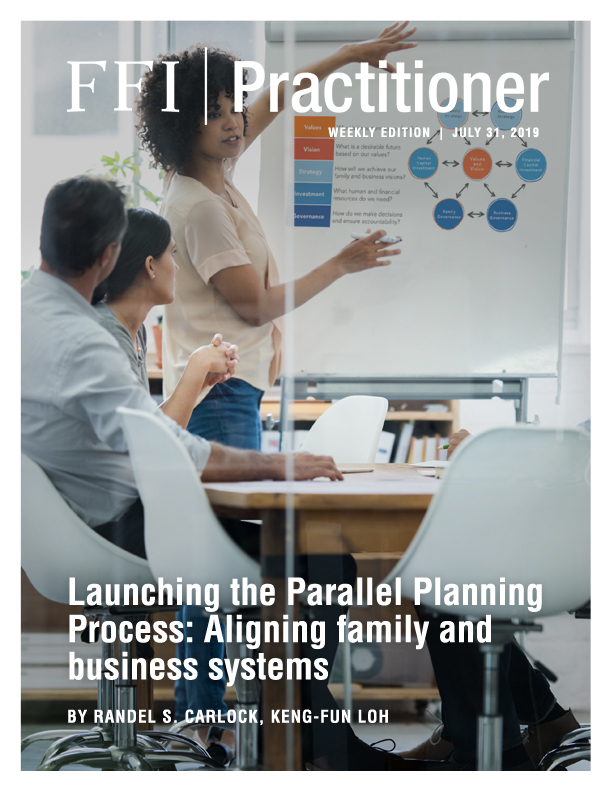
Thank you to this week’s contributors, Randel Carlock and Keng-Fun Loh, for this examination of the enhanced Parallel Planning Process (PPP), a tool that can help advisors to professionalize the family and business planning process.
Planning professionally to develop plans and actions that align both the family and business can be a daunting task that family business leaders have often ignored or avoided—especially for the family.
We have found that the best performing family businesses professionally plan family and business strategy, investment, and governance, while leading with an emotional commitment to values and vision; in short, they are professionally emotional. Although this sounds like an oxymoron, our experience shows that families must align their technical planning, while including emotions in their leadership that empowers and strengthens the family’s commitment.
Enhanced Parallel Planning Process (PPP): 360° Online Planning Assessment and Map
The PPP is an established tool to professionalize family and business planning. 1That helps families and their businesses plan in parallel for the five critical PPP factors of values, vision, strategy, investment, and governance by crafting plans that align the family and business systems (Figure 1).
Figure 1 – PPP: Five Planning Factors

It can also be seen as both a leadership activity that improves family communication and as a planning tool that aligns and improves decision-making for family and business activities. When families learn to communicate their implicit feelings and ideas, making them explicit, they develop new communication skills and strengthen their family relationships. Although the family may not immediately reach an agreement on their plans or action steps, “risking” the conversation creates a more engaged family.
When families learn to communicate their implicit feelings and ideas, making them explicit, they develop new communication skills and strengthen their family relationships.
Business families face many planning challenges including clarifying family values, agreeing on a shared future, aligning the business and family’s plans and actions, and strengthening relationships. Three implementation tasks that help business families benefit from the enhanced PPP by addressing these planning challenges are:
Task 1: Engage the family using the PPP Framework as a mental model that creates a shared vocabulary and roadmap;
Task 2: Collect, analyze, and discuss data using the Basic360 Profile, as an online 360° assessment of the family and business’s planning concerns; and
Task 3: Complete the PPP Map to visually align the family and business’s plans and provide a record of the family’s decisions requiring further action (Figure 2).
Figure 2 – PPP: Three Implementation Tasks

Task 1: Engage the family using the PPP Framework as a mental model.
The PPP is a systemic approach for encouraging family thinking, sharing information, and making planning decisions. It works as a mental model to structure the planning process and enables each family to plan according to its own values and vision. Family business planning is never easy because every situation is as unique as the family that owns the business—yet they all require sound planning for family values, vision, strategy, investment, and governance.
The PPP encourages family participation because it “levels the playing field” by helping family members, with or without business literacy, to participate, intuitively guiding family and business planning. The outcome is an opportunity for family members to contribute in developing family and enterprise plans; this involvement makes them much more likely to support the family’s plans and actions.
The PPP is a systemic approach for engaging family thinking, sharing information, and making planning decisions.
Task 2: Collect, analyze, and discuss family and business planning data using the Basic360 Profile.
Professionally managed organizations start their planning activities by collecting information on their current plans and performance. They do this to have accurate data on their current situation and planning opportunities, and equally important, to motivate organizational support for the changes created by planning. Unfortunately, business families tend to be less rigorous in assessing their current challenges, especially when they relate to the family. Planning based on an understanding of the family’s concerns and current performance is important for business families because what gets measured and discussed can be planned and improved.
Sidebar
This week’s contributors, Randel Carlock and Keng-Fun Loh reveal why planning space travel has some important similarities with how family enterprises should plot ambitious futures.
Figure 3 provides quantitative data from a Likert scale on the five family and business planning factors using family planning statements such as, “Our family values drive decision-making” and “We hold regular family meetings” and business planning statements such as, “Our business culture reflects our family values” and “Our board contributes to the strategic planning process”.
Figure 3 – Basic360 Profile Feedback Report: The group average versus individual scores for each dimension
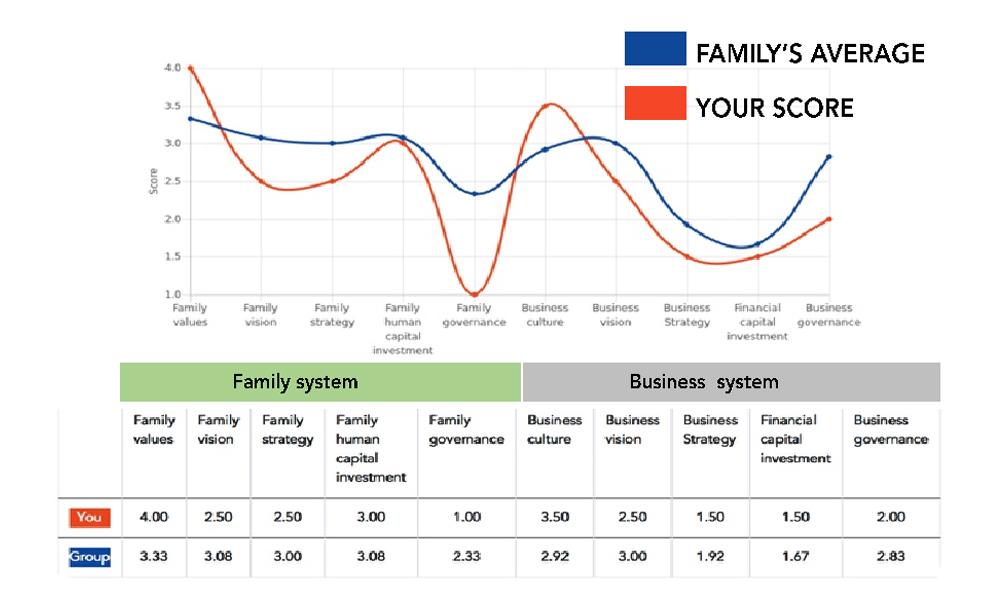
Additionally, the assessment asks several open-ended qualitative questions to support sharing of information specific to the family. Consider the experience of one MBA student’s family who were all surprised when they individually answered the question: What barrier is preventing your family from planning more effectively? The two parents reported “None” and “There are no barriers” while the four next-generation family members (including the student), who all work in the business, reported “a lack of open discussions about the company”, “managerial knowledge is not passed on to the next generation”, “no medium and long-term planning and limited communication” and “planning related to sales growth”. (Figure 4)
Figure 4 – Basic360 Profile Narrative Question
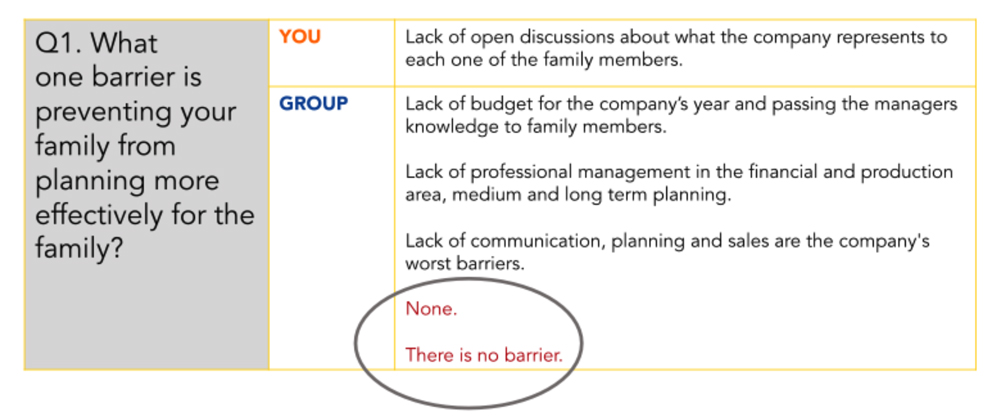
The responses indicate that the four next-generation members are experiencing a very different family business than their parents. They are saying, “we need improved communication, planning and professionalism to make our business stronger”. Although this feedback does not prove that the four siblings’ concerns are correct, the consistency of their responses indicates that the two generations need to better understand each other’s perspectives as they develop their future plans.
Task 3: Complete the PPP Map to align family and business plans and confirm action steps.
This activity allows family members to sketch out new ideas and test the relationship among various planning actions—just as an architect sketches a blueprint for a new building.
The Map provides a framework for discussing the family feedback from Task 2 to identify plans and action steps to improve the family and business’s performance. Some families identify actions for each of the eight sections (Figure 5) and then rank them as priorities.
Figure 5 – The PPP Map
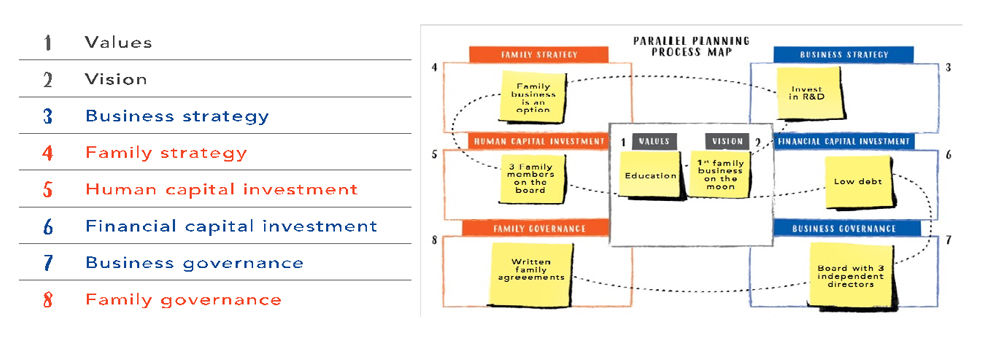
This mapping provides families with a helicopter view of the different planning activities such as strengthening governance and then an action step like recruiting two independent directors. It is interesting to note the difference on Figure 6 between the right-hand side (business) and the left-hand side (family) of the Map. This business family, like most of the families completing the PPP Map at INSEAD, has more plans and action steps for the family than for its business.
Figure 6 – The Completed PPP Map
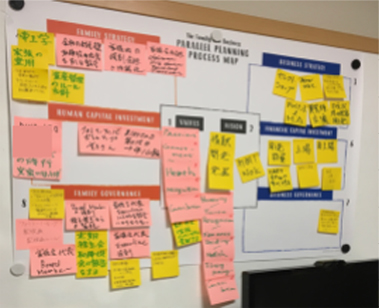
Conclusion and Future Plans
For the past 20 years, the Parallel Planning Process has helped business families intellectually understand family business planning. The addition of the 360° online feedback and the PPP Map creates a more comprehensive planning process that moves beyond family discussions and into real-world applications, empowering families with proven tools to co-create their family and business future, based on their own values and vision. Active participation and the struggle to design and plan together creates family success and empowerment. A family that confirms its shared values and is talking about the future is moving in the right direction — communicating new possibilities for sustaining the business and building long-term family commitment.
Footnotes
1About the Parallel Planning Process: The PPP is a proven tool to professionalize family and business planning that was introduced in Strategic Planning for the Family Business (2001) and improved in When Family Businesses are Best (2010) by Carlock and Ward. Recently enhanced in A Family Business on the Moon (2018)., it now includes a comprehensive planning system with Basic and Advanced online 360° assessments and a simple-to-visualize planning map.
2Lewin, K. (1951). Frontiers in group dynamics. In D. Cartwright (Ed.), Field theory in social science (pp. 188–237). CN: Greenwood Press.


Randel S. Carlock is a professor, coach, family therapist, entrepreneur, and former CEO and Chairman of a NASDAQ listed company. He is founding director of two university-based family business research centres, and has postgraduate training in family and marriage therapy at King’s College and psychodynamic counseling at Birkbeck College, both in London. He is author of several books, including When Family Businesses are Best with John L. Ward, and Family Business on the Couch with Manfred Kets de Vries. A Family Business on the Moon (2018), co-authored with Keng-Fun Loh, represents a completely new style of learning based on family communication driven by shared real-world experiences. Randel can be reached at randel.carlock@insead.edu.
Keng-Fun Loh has over 25 years of building teams and relationships with wealthy and enterprising families around the world, through senior roles as market head, head of customer experience, and marketing director at Citi, Credit Suisse, and Standard Chartered Bank. Besides advising enterprising families, she also develops programs and tools, and researches and contributes articles about family enterprises to publications. She holds the FFI Certificate in Family Business Advising and is a member of its Asian Circle study group. Keng-Fun can be reached at kfun.loh@gmail.com.
Family and Business Learning is a new educational approach for family enterprises, business families, entrepreneurs, and the professionals who support them. Launched in 2018 by Professor Randel S. Carlock and Keng-Fun Loh, the goal is to broaden the reach of new learning platforms with tools that accelerate learning and build learning communities based on each family or business’s unique situation, rather than best practices and theories developed by business schools and consultants. The learning focuses on the social tasks of leadership, talent development and human relationships rather than the technical and business tasks.


Keng-Fun Loh has over 25 years of building teams and relationships with wealthy and enterprising families around the world, through senior roles as market head, head of customer experience, and marketing director at Citi, Credit Suisse, and Standard Chartered Bank. Besides advising enterprising families, she also develops programs and tools, and researches and contributes articles about family enterprises to publications. She holds the FFI Certificate in Family Business Advising and is a member of its Asian Circle study group.
TBD
Related Article

“An Interview with Dr. Salvatore Tomaselli: The Family-in-Business Model Canvas” hosted by Lanie Jordan
